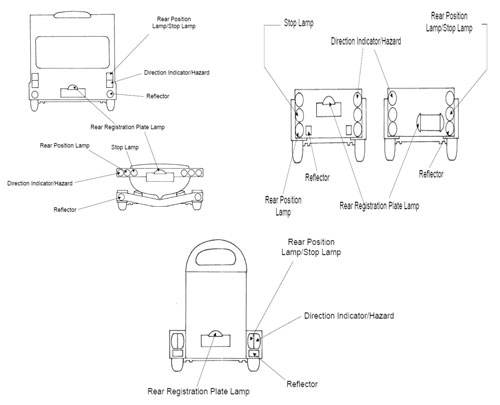REGULATIONS AND REQUIREMENTS
Ensuring your trailer has the appropriate lighting is a legal requirement . This simple guide will help you to be within the current laws for use on the UK public highway.
Trailers must have fitted:
- Two red sidelights.
- Two red stoplights.
- Two red reflective triangles.
- An illuminated number plate.
- White front reflectors
- Amber indicators (designed to flash between 60-120 times per minute).
- Some form of letting the driver know trailer indicators are working correctly such as a buzzer or light.
If the trailer is more than 1.3m wide they also require
- At least one red fog lamp.
Larger trailers (1.6m and over) require additional features:
- White front reflectors.
- White front markers/lights.
Trailers Manufactured from October 2012 fitted with brakes require additional features:
- Reverse light
Longer trailers (6m and over, excluding drawbar, but not boat trailers) require additional features:
- Red/White side markers.
Arranging lights and reflectors:
- Indicators should be a minimum of 350mm and a maximum of 1500mm from the ground.
- Indicators should be a maximum of 400mm from the side of the trailer.
- Indicators should be a minimum of 400mm apart.
- Reflective rear triangles should be positioned, a minimum of 250mm and a maximum of 900mm from the ground, a minimum separation of 600mm and no more than 400mm from the sides.
- A single fog lamp should be mounted on the rear of the trailer, anywhere between the centre point and offside edge.
- Two fog lamps must be separated and positioned at opposite sides of the rear of the trailer.
- Fog lamps should be a minimum of 250mm and a maximum of 1000mm from the ground.
- Fog lamps should be a minimum of 400mm apart.
- There should be at least of 100mm of separation between the fog lights and the tail lights/indicators.
Installation of Lights – All Trailer
The trailer must be fitted with lamps or retro reflective material only capable of showing a white light to the front except for:
- an amber light from a direction indicator
- An amber light from a hazard beacon/warning lamp
- a yellow light from a conspicuity marking material
- an amber light from a side marker light
- The trailer must be fitted with lamps or retro reflective material only
capable of showing a red light to the rear except for:
-an amber light from a direction indicator
– an amber light from a hazard beacon/warning lamp
– a white light from a work lamp, reversing lamp, interior lamp, or a
registration plate lamp
– a yellow light from a rear registration plate
– a yellow light from a conspicuity marking material
– an amber light from a side marker light
– emergency vehicles only, a blue light from an external warning
lamp or beacon. - The operation of any lamp must not affect any other lamp or be
affected by the operation of any other lamp, unless specifically
designed to do so trailer and not move by swivelling, deflecting, or otherwise while the trailer is in motion, except for a work lamp, used to illuminate a working area or the scene of an accident, breakdown or road works in the vicinity of the trailer to which it is fitted. - All obligatory and optional lamps, reflectors and rear markers must be fitted to their correct orientation.
- When every door or other movable part is in the fixed open position
(any position in which the component will remain, with or without a fixed stay) the
– front and rear position lamps
-front and rear indicators
– rear retro reflectors - must fulfil one of the following conditions:
a. half (50%) of the apparent surface of the lamp or reflector is visible
from directly in front of / behind as appropriate the trailer, or
b. additional fully visible lamp (s) / reflectors satisfying all requirements
for the above lamps / reflectors are activated / visible, or
c. a notice on the trailer must inform the user that in certain positions
of the movable components, other road users should be warned of
the presence of the trailer on the road (e.g. by laying out a warning
triangle).
Figure 1 Horizontal Angles of Visibility
Each lamp and reflector must be positioned such as to provide an “apparent surface”. At least 50% of the “apparent surface” of each lamp or reflector must be visible from any point within the relevant angles
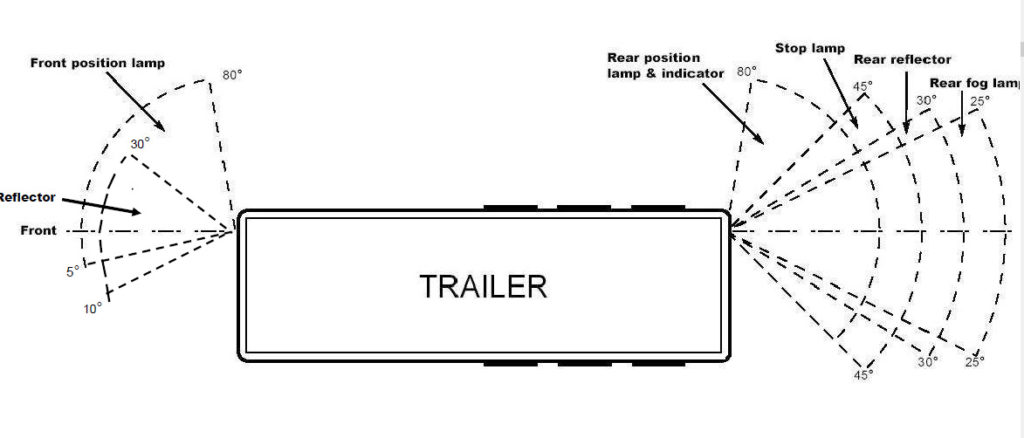
Figure 2 – Vertical Angles of Visibility
Each lamp and reflector must be positioned such as to provide an “apparent surface”. At least 50% of the “apparent surface” of each lamp or reflector must be visible from any point within the relevant angles.
Front Position Lamps, Retro Reflectors and Indicators (including Side Repeaters)
‘a’ = less than 750mm above ground level.
‘b’ = 750mm or more above ground level.
‘ar’ = Front retro reflector less than 750mm above ground level
‘br’ = Front retro reflector more than 750mm above ground level
‘c’ = Rear position lamps and Stop lamps 1500mm or more above ground level. Indicators and Rear reflectors 750mm or more above ground level.
‘d’ = Rear position lamps and Stop lamps less than 1500mm above ground level.
‘e’ = Rear position lamps, Stop lamps, Indicators and Rear reflectors less than 750mm above ground level.
‘f’ = Rear fog lamps.

Figure 3 “To the rear” of the trailer means “in an area the sides of which are at an angle of 15 degrees
out from the extreme outer edge of the trailer, (starting from the rear corner) and extending up to 25m from the rear of the trailer (measured along the trailer longitudinal).

Retro reflectors;
- All reflectors must be ‘e’ or ‘E’ marked and where applicable.
- Rear reflectors must face predominately to the rear.
Conspicuity Markings; trailers above 3500kgs - Conspicuity Markings must only be applied to the correct category of trailer.
- All conspicuity marking material must be of an approved type
- There must be at least one visible approval mark on an element of a retroreflective marking material fitted to each face of the vehicl
- The maximum gap between adjacent elements must be no greater than 50% of the smallest adjacent element.
- The lowest edge must be between 250mm and 1500mm from the ground.
- The minimum width of the markings must be at least 50mm.
- The maximum width of the markings must be no greater than 60mm.
Rear Conspicuity Markings; trailers over 3500kg and over 2.1m wide - must be coloured either red or yellow
- must cover at least 70% of the overall trailer width.
- must be at least 200mm away from any mandatory brake light
Side Conspicuity markings; trailers over 3500kg and over 6 metres in length - must be coloured either white or yellow
- must extend within 600mm of either end of the trailer (see figure 2)
- must cover at least 70% of the overall trailer length – If Full or Partial Contour Markings are fitted
- The maximum height must be as close as is practical to the top of the body. (See figure 2).
End-outline, Position (Side), Stop and Side Marker Lamps
- All lamps must be ‘e’ or ‘E’ marked and where applicable.
- Front and Rear Position Lamps;
- The correct number must be fitted to the trailer .
- They must be operational.They must only emit white light to the front / red light to the rear.
Stop Lamps;
- The correct number must be fitted to the trailer .
- They must be operational.
- They must only emit red light.
- They must only illuminate when the service brake is applied, and must extinguish when the service brake is released.
Side Marker lamps;
The correct number must be fitted to the trailer (in accordance to the
positional requirements).
They must be operational.
They must emit an amber light (red is permitted if within 1 metre of the rear).
End Outline Marker Lamps;
Directional Indicators;
- All lamps must be ‘e’ or ‘E’ marked and where applicable.
- They must be operational.
- The correct number must be fitted to the trailer .
- They must flash at a rate of between 60 and 120 times a minute (with all mandatory indicators working, and with the engine running on the towing vehicle if initially below the requirement).
- All lamps must emit amber light.
- The hazard warning device must operate all of the direction indicators simultaneously
Types of trailer
Pig Trailer
A trailer having one axle group near the middle of the length of its goods carrying surface.

Dog Trailer
A trailer with 2 axle groups of which the front axle group is steered by connection to the drawing Vehicle.
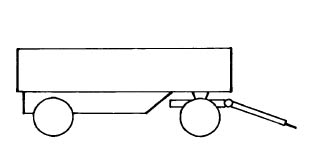
Semi-Trailer
A trailer having one axle group towards the rear end of the length of its goods carrying surface such that significant load is imposed on the drawing vehicle. Or some of the goods carrying surface is over the towing vehicle.
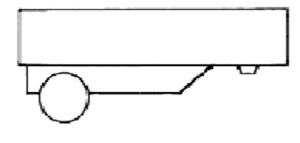
Caravan
An enclosed trailer, which is intended for use as a mobile home or living quarters when parked. It will usually provide fixed sleeping accommodation and/or facilities for the preparation of food.
A trailer permanently equipped with a folding and stowable roof (such as a camper trailer) is a caravan. Enclosed trailers constructed for the accommodation of people when parked such as workers’ amenity trailers, mobile kitchens or mobile offices are also regarded as caravans.
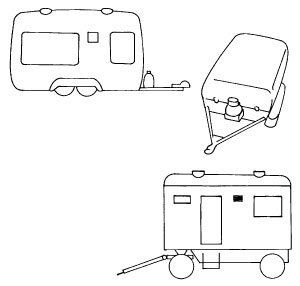
Box Trailer
A general-purpose trailer with a load space, which is bounded by vertical sides. This category includes a box trailer fitted with a canopy but which is not equipped as a caravan, e.g. is equipped with temporary sleeping accommodation only.
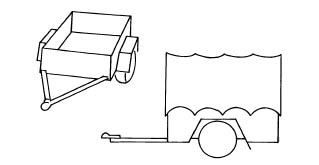
Tray Body (Table Top) Trailer
A general-purpose trailer with flat load deck, which is not bounded by vertical sides.

Boat Trailer
A trailer built specifically to carry a boat.
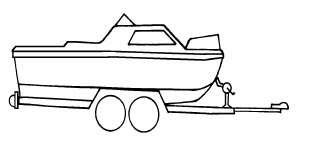
Car Trailer
A trailer built specifically to carry a motor vehicle such as a passenger car or racing car.
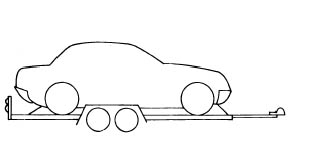
Horse Float
A trailer built to carry one or more horses or other similar livestock.
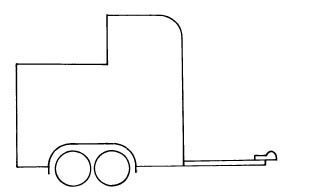
Plant Trailer
A trailer which, instead of a load space, has fixed to it machinery such as an air compressor, concrete mixer or drilling rig.
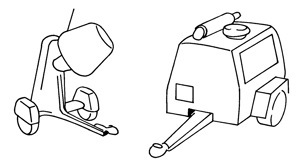
Grouping of Rear Lamps
Rear position (side) lamps, stop lamps, direction indicator lamps, registration plate lamps and retro-reflectors may be grouped into the same units, as long as their individual requirements are met.
The following are examples of acceptable arrangements.
